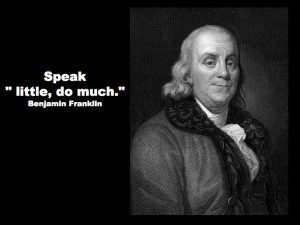Executives and business leaders in general are conditioned to be rational. Schools are designed to imbue knowledge. Shareholders pay for performance. Money is counted in numbers. Information is power. And yet…
The power of true leadership is run through the emotional pipeline #leadership #Mindset http://t.co/tcUUDgzeoj
— Minter Dial (@mdial) June 10, 2014
Great leadership involves a (non-exhaustive) cocktail of the below:
- Inspiration
- Courage
- Instinct
- Decisiveness
- Engagement
- Energy
- Emotion
- Empathy
Unfortunately, these attributes are neither taught in school, acknowledged in business, nor directly rewarded by the stock market. The issue is that by focusing on the highly rational actions — loaded with plenty of analysis, insights, caution and contingency planning — it seems that we are programmed to reach for mediocrity.
Clear Communication
Most teams feel that they are working hard — at least the managers will likely say as much. The vast majority of executives are over worked, (probably overly) taxed by the pressure to perform. Many companies are now talking about digital transformation (or ‘digitization’), customer centricity, and the war for talent. These are common threads throughout any forward thinking company. The major challenge, however, is to create an environment (culture) that facilitates learning and enables transformation. Effective communication is at the heart of the challenge. To the extent that communication is the lifeblood of an organization, it must be part of the chief executive’s mandate to evaluate how information flows throughout the organization. To make things simple, there are four major communication vectors:
- Outgoing (to external parties): commercial messages, employer branding, corporate communications…
- Internal Top Down: messages coming from the top in internal memos, at town hall meetings, etc.
- Internal Within: peer-to-peer, messages from the field, inter-departmental, inter-subsidiaries…
- Incoming: client messages and complaints, supplier support and, the burgeoning information on the web…
In a hyper-connected environment with infobesity and data in excess, having clarity of vision and expression is increasingly the issue. With communications now coming through an assortment of channels on a 24/7 level, getting the jigsaw puzzle of communications right is absolutely strategic. If the strategy is clear, the next hurdle is to make sure that it flows throughout the organization to become a de facto reality. Making that happen means moving beyond intelligent headlines and well-written memos. The authenticity and vibrancy of the message will be pivotal.
Non-verbal Communication
A leader’s communication style is absolutely essential for getting the organization to move and activate a given strategy. When looking at the overly simplistic statement that 93% of communication is non-verbal,* one could be tempted to send all executives back to drama school. However, it is absolutely vital to distinguish between rational messages and communications that involve emotions. As Dr Albert Mehrabian, himself, said about the findings of his research,
Unless a communicator is talking about their feelings or attitudes, these equations are not applicable. (Quote by Dr Mehrabian, via Olivia Mitchell’s Speaking About Presenting)
Nonetheless, going back to great leadership from the top of this post, the ability for a leader to galvanize the troops to create a competitively superior effort, will be deeply linked to his or her personality. Does the leader believe personally in the cause? Does the leader embody the values of the group on a professional and personal level? The credibility of the leader, when expressing his/her vision of the strategy, will be betrayed by non-verbal cues. And hiding from communications — or not communicating enough — diminishes the chances of driving the beliefs throughout the organization.
Digital transformation starts with internal communications
In the four vectors of communications cited above, two are internal. The role of the internal communications — be they intranet, email or corporate social networks — is tremendously important in the context of agility, sharing, co-creation, breaking down silos and, above all, employee engagement. As companies continue to tackle the digital transformation challenge, it seems a strategic priority to make sure that the company is walking the talk internally. This is not a sequential affair, where fluid and ‘social‘ internal communications must happen first.  However, the C-suite must be mobilized to make the internal communications more fluid and more engaging. A corporate social network must become a ground where “test & learn” is encouraged. {Tweet this!} I encourage any CEO to evaluate the following questions about him or herself and all the members of the C-suite:
However, the C-suite must be mobilized to make the internal communications more fluid and more engaging. A corporate social network must become a ground where “test & learn” is encouraged. {Tweet this!} I encourage any CEO to evaluate the following questions about him or herself and all the members of the C-suite:
- who is actively participating on the internal communication platforms in an open, engaged and sharing mindset?
- who is active on Twitter or LinkedIn (or other relevant social media)?
- is anyone blogging?
- who is subscribed to Wired?
- who is reading Brian Solis, Mitch Joel or Seth Godin’s blog or other such thought leaders?
If the answer is none, then the first work of digital transformation can legitimately start there! Members of the C-suite must understand that these skills and activities are not to be delegated, anymore than writing an email can be written by the intern. By modeling the behavior, culture can and will be shaped and changed. It is not by saying, but by doing that trust and engagement will be improved and fostered. Giving of oneself and showing one’s personality will inspire others to follow suit. Of course, the tone and content must be authentic and congruent with the company’s mission and purpose. I like to say that change happens when people believe why. {Tweet this!}
Your thoughts and reactions please!













I have been interviewing for a new team leader during the last couple of weeks and the thing that I realised I’m looking for is:
Passion
Wouldn’t passion be achieved by mixing most of the ingredients of your excellent cocktail?
BTW – the one thing that cv’s so quickly kill is passion. If you cv doesn’t really show your passion (for anything – it really doesn’t matter) then it’s a waste of time.